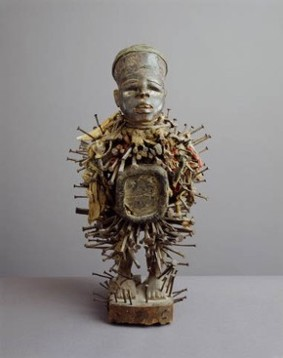Nkondi:
The most striking type of Minkisi was called Nkondi-- the hunter-- and had hunting down evil as its purpose. Before 1921, when their influence began to be supressed by missionaries, Nkondi were considered the most important type of Minkisi. They belong to the category of "minkisi of the above" and appealed to rain, thunder, lightning, fire and birds of prey. A popular analogy was that Nkondi swoop down on their victim much in the same way that a a hawk attacks its prey. Their physical focus was also that of the above; they caused headaches, stiff necks or even falls from trees.

A person who had been wronged in a certain way-- victim of theft or witchcraft- would visit the chief, ngaga, and pay him to push nails into an Nknodi. This is done to call upon the spirit, and activate its anger and power. At night, the Nkondi would hunt down the culprit and strike him or her with an illness. Eventually, a person would begin having chest pains or severe headaches, for instance, and it would be asumed that he or her was the wrongdoer. The said culprit would then have to pay the chief to convince the Nkondi to stop attacking him or her. This caused and lead the nkondi to play a vital part in maintaining social order in groups or villages.
They contain a pocket of medicine, which is filled depending on its form: Nkondi of the Water, Nkondi a Mungundu ('the sawing bird'), Nkondi a Mantuku ('causes difficult breathing') and Nkondi of the Sudden Curse. These differences affect the type of treatment used and what symptoms will appear in the victim. For instance, the Nkondi of the Water will strike someone in the water, and kill him or her there.
Nkondi are made of wood and have dramatic nails sticking into the totality of the sculpture. Not all Nkondi were nailed, although these have attained fame that other Nkondi have not. The color red was also an identifying feature of the Nkondi. The form of the Nkondi can be symbolic of its function; especially when inflicting deformations on a subject. If the particular Nkondi was a Na Kongo type, it would have twisted arms and legs. If a pair of lips and a nose were lacking, the Nkondi type would be an Mbola. Creating a Nkondi would require between three and four months of work by the chief, ngaga. He could only work on it on the outskirts of the village, out of fear that the newly created, unbriddled spirit of the Nkondi could harm people.
Most Nkondi were male, which is deeply related to their violent, powerful nature. Although certain Nkondi were female, these were deemed less aggressive.
Back to The Voodoo doll
